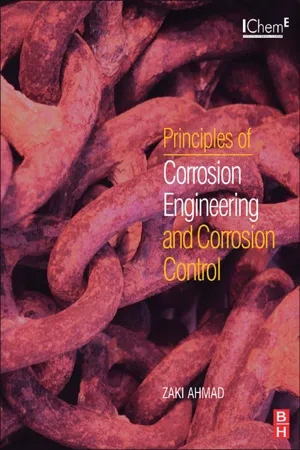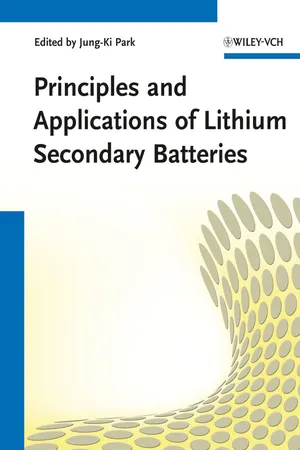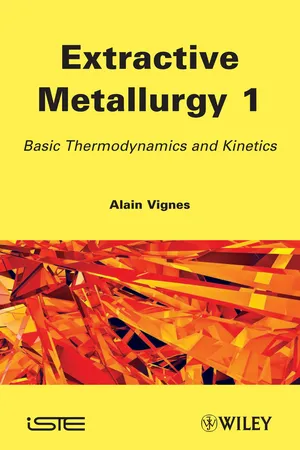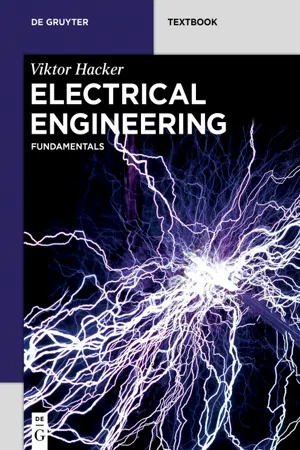Chemistry
Electrochemical Series
The electrochemical series is a list of metals and nonmetals arranged in order of their standard electrode potentials. This series helps predict the direction of redox reactions and the relative reactivity of different substances. It is a valuable tool in understanding and predicting the behavior of elements in electrochemical processes such as corrosion and electrolysis.
Written by Perlego with AI-assistance
6 Key excerpts on "Electrochemical Series"
Learn about this page
Index pages curate the most relevant extracts from our library of academic textbooks. They’ve been created using an in-house natural language model (NLM), each adding context and meaning to key research topics.
- Zaki Ahmad(Author)
- 2006(Publication Date)
- Butterworth-Heinemann(Publisher)
Table 2.1 ).2.13.6 SUMMARY OF CHARACTERISTICS OF EMF SERIES (TABLE 2.1 )
(1) Metals with large positive potentials are called ’noble’ metals because they do not dissolve easily. Examples are copper, silver, gold, etc. The potential of a noble metal is preceded by a positive (+) sign.(2) The electrode potentials are thermodynamic quantities and have little relevance to potential of metals in solution encountered in service. (3) The emf series lists only the electrode potentials of metals and not alloys. Alloys are not considered in the emf series.(4) The emf series is based on pure metals. The more active metals, such as Na, Mg, Al, Zn are called ’active metals’(5) Alloys are not considered in the emf series. (6) From the reversible electrode potential in the standard emf series of metals, it is possible to predict whether a particular metal will spontaneously dissolve. (7) It gives an indication of how active the metal is but does not necessarily predict corrosion accurately for reason to be explained later in the next chapter.2.13.7 APPLICATION OF EMF SERIES
Following are useful applications of emf series:(1) A less electropositive metal would displace a more electropositive metal from one of its salts in aqueous solution. For instance, if a rod of zinc is placed in a solution of copper sulfate, zinc would dissolve in the solution and copper would be discharged:Zn +CuSO 4→ZnSO 4+ Cuor Zn →Zn+ 2 e+ +( oxidation )Cu+ 2 e → Cu+ +( reduction )Consequently, copper will deposit on the zinc rod.(2) Electrode potentials indicate also the tendency of cations in aqueous solutions to be reduced at a cathode. For example, silver ions are reduced more readily than cupric ions, because silver is more electropositive.(3) Metal ions above hydrogen are more readily reduced than the hydrogen ions with 100% efficiency.- Jung-Ki Park, Jung-Ki Park(Authors)
- 2012(Publication Date)
- Wiley-VCH(Publisher)
Chapter 2 The Basic of Battery Chemistry Electrochemistry is the study of electron transfer caused by redox reactions at the interface of an electron conductor, such as a metal or a semiconductor, and an ionic conductor, such as an electrolyte. Technologies based on electrochemistry include batteries, semiconductors, etching, electrolysis, and plating. In this book, electrochemistry refers to the conversion of chemical energy into electric energy in various systems such as primary batteries, secondary batteries, and fuel cells. In particular, this chapter describes the electrochemical aspects of secondary batteries. 2.1 Components of Batteries 2.1.1 Electrochemical Cells and Batteries An electrochemical cell is the smallest unit of a device that converts chemical energy to electric energy, or vice versa. In general, a battery has multiple electrochemical cells, but it may be used to refer to a single cell. An electrochemical cell consists of two different electrodes and an electrolyte. The two electrodes of different electric potential create a potential difference when immersed in the electrolyte. This potential difference is also known as electromotive force. Electric potential, denoted by V, is the potential energy of a unit charge within an electric field, and electromotive force drives current in an electric circuit. Redox reactions occur at each electrode due to this force and the generated electrons pass through the external circuit- Kevin Reel, Derrick C. Wood, Scott A. Best(Authors)
- 2014(Publication Date)
- Research & Education Association(Publisher)
13Electrochemistry
Application of Redox
Electrochemistry is the application of oxidation and reduction half reactions. There are numerous oxidation–reduction (redox) reactions that occur spontaneously, such as the displacement of silver metal when a copper wire is submerged in a silver nitrate solution.Thermochemistry is closely associated with electrochemistry. The Gibbs free energy, ΔG, not only indicates whether a reaction is spontaneous or nonspontaneous, it also is a measure of the amount of work that can be done by a system on its surroundings. Although the preceding reaction is spontaneous, the free energy of this reaction cannot be harnessed.In electrochemistry, there are two different types of electrochemical cells:1. A voltaic cell (galvanic cell) is commonly called a battery. This type of cell contains a spontaneous chemical reaction that produces electricity and supplies it to an external circuit.2. Nonspontaneous reactions give rise to an electrolytic cell . This cell uses electrical energy from an external source to force a nonspontaneous redox reaction to occur.DID YOUKNOW?The coating of metals onto a second surface is accomplished through a process called electroplating . Chrome—which is found on car bumpers, motorcycle frames, and exhausts—is a thin layer of chromium plated onto steel. The chromium not only adds an attractive silvery shine, but also inhibits corrosion.Voltaic Cells
Electrical conduction in chemistry occurs through the motion of electrons through a metallic medium or by the movement of ions in an aqueous solution or molten salt. In order to harness the free energy of a spontaneous redox reaction, the two half-reactions of the redox reaction are separated into two half-cells. These half-cells consist of an electrode and a solution of the ion involved in either the oxidation or reduction process. Electrodes are surfaces upon which a reduction or oxidation half-reaction occurs. They may participate in the reaction or simply serve as a medium through which electrons travel (inert electrode). The mnemonic “Red Cat and An Ox” is useful to help remember that reduction occurs at the cathode (positive electrode) and oxidation at the anode (negative electrode). See Figure 13.1- eBook - ePub
Extractive Metallurgy 1
Basic Thermodynamics and Kinetics
- Alain Vignes(Author)
- 2013(Publication Date)
- Wiley-ISTE(Publisher)
Chapter 8Electrochemical Reactions
8.1. Overview of electrochemical processes
A chemical reaction is a reaction where only chemical species (neutral molecules and positively or negatively charged ions) are involved. An electrochemical reaction is a reaction where chemical species and free electrons are involved. The two elementary electrochemical reactions are:– oxidation : liberation of electrons. For a metal (in the solid state) immersed in an electrolytic solution, the reaction is a dissolution, which gives a metallic ion in solution (corrosion):[8.1.1]– reduction : absorption of electrons. For a metallic ion in an aqueous solution (heterogeneous precipitation, see Chapter 5 , section 5.6.1 ):[8.1.2]Various overall reactions are the result of elementary electrochemical reactions:– redox chemical reactions resulting from two simultaneous elementary electrochemical reactions where the electrons are directly transferred between the reactants. They are homogeneous chemical reactions (see Chapter 5 , section 5.2.1.1 - eBook - ePub
Electrical Engineering
Fundamentals
- Viktor Hacker, Christof Sumereder(Authors)
- 2020(Publication Date)
- De Gruyter Oldenbourg(Publisher)
noble (do “not like” to oxidise), they dissolve less easily. The greater the distance of two metals on the Electrochemical Series, the higher the voltage between them.Δ E = Ec a t h o d e− Ea n o d eIf we take the Daniell cell (copper and zinc electrode) as an example for this, we get a cell voltage of 1.1 V (0.35 V + 0.76 V). Thus you can determine the electromotive force (emf, cell voltage) with the difference between two numeric values.Table 6.2: Electrochemical Series at 25 °C; 101.3 kPa; pH=0; ion activities=1.Element oxidised form + z e− ⇌ reduced form E ° Element oxidised form + z e− ⇌ reduced form E ° Fluorine (F) F2 + 2 e− ⇌ 2 F− +2.87 V Indium (In) In3+ + 3 e− ⇌ In −0.34 V Oxygen (O) H2 O2 + 2 H3 O+ + 2 e− ⇌ 4 H2 O +1.78 V Iron (Fe) Fe2+ + 2 e− ⇌ Fe −0.41 V Gold (Au) Au3+ + 3 e− ⇌ Au +1.50 V Sulphur (S) S + 2 e− ⇌ S2− −0.48 V Chromium (Cr) Cr6+ + 3 e− ⇌ Cr3+ +1.33 V Nickel (Ni) NiO2 + 2 H2 O + 2 e− ⇌ Ni(OH)2 + 2 OH− −0.49 V Oxygen (O) O2 + 4 H+ + 4 e− ⇌ 2 H2 O +1.23 V Zinc (Zn) Zn2+ + 2 e− ⇌ Zn −0.76 V Platinum (Pt) Pt2+ + 2 e− ⇌ Pt +1.20 V Water 2 H2 O + 2 e− ⇌ H2 + 2 OH− −0.83 V Palladium (Pd) Pd2+ + 2 e− ⇌ Pd +0.85 V Chromium (Cr) Cr2+ + 2 e− ⇌ Cr −0.91 V Silver (Ag) Ag+ + e− ⇌ Ag +0.80 V Vanadium (V) V2+ + 2 e− ⇌ V −1.17 V Iron (Fe) Fe3+ + e− ⇌ Fe2+ +0.77 V Manganese (Mn) Mn2+ + 2 e− ⇌ Mn −1.18 V Copper (Cu) Cu+ + e− ⇌ Cu +0.52 V Titanium (Ti) Ti3+ + 3 e− ⇌ Ti −1.21 V Iron (Fe) [Fe(CN)6 ]3− + e− ⇌ [Fe(CN)6 ]4− +0.36 V Aluminium (Al) Al3+ + 3 e− ⇌ Al −1.66 V Copper (Cu) Cu2+ + 2 e− ⇌ Cu +0.35 V Cerium (Ce) Ce3+ + 3 e− ⇌ Ce −2.483 V Hydrogen (H2 ) 2 H+ + 2 e− - eBook - ePub
- Jeffrey Gaffney, Nancy Marley(Authors)
- 2017(Publication Date)
- Elsevier(Publisher)
Chapter 10Oxidation-Reduction Reactions and Electrochemistry
Abstract
This chapter explains the principles of oxidation and reduction, including the roles of the oxidizing and reducing agents and how to determine oxidation states. The construction and operation of a galvanic cell is overviewed and the function of the anode and cathode explained. The importance of balancing the half reactions first when balancing oxidation-reduction chemical equations is stressed. Also covered are the importance of standard cell potentials and the designation of the standard hydrogen electrode as the electrode by which all others are measured. Methods of determining the cell potentials both under standard and nonstandard conditions are given. A Case Study on the use of cathode protection in structural metals and the role of concentration cells in corrosion are discussed to stress the importance of oxidation-reduction principles to engineering. Other topics discussed are the application of oxidation-reduction chemistry in electrolysis and battery and fuel cell construction.Keywords
Oxidation-reduction; Galvanic cell; Cathode; Anode; SHE; Standard potentials; Nernst equation; Electrolysis; Battery; Fuel cellOutline10.1Oxidation-Reduction Reactions10.2The Galvanic Cell10.3Balancing Oxidation-Reduction Equations10.4Standard Cell Potentials10.5Reactions at Nonstandard Conditions: The Nernst Equation10.6Electrolysis10.7Batteries10.8Fuel CellsImportant TermsStudy QuestionsProblems10.1 Oxidation-Reduction Reactions
Many common chemical reactions, such as the acid-base reactions, discussed in Chapter 5 , are based on the transfer of a proton (H+ ) between reactants. Another common type of chemical reactions involves the transfer of electrons between reactants. The branch of chemistry that studies this type of reactions is electrochemistry , the study of chemical processes that cause electrons to move. These chemical reactions that involve the transfer of electrons from one reactant to another are called oxidation -reduction reactions, or redox





